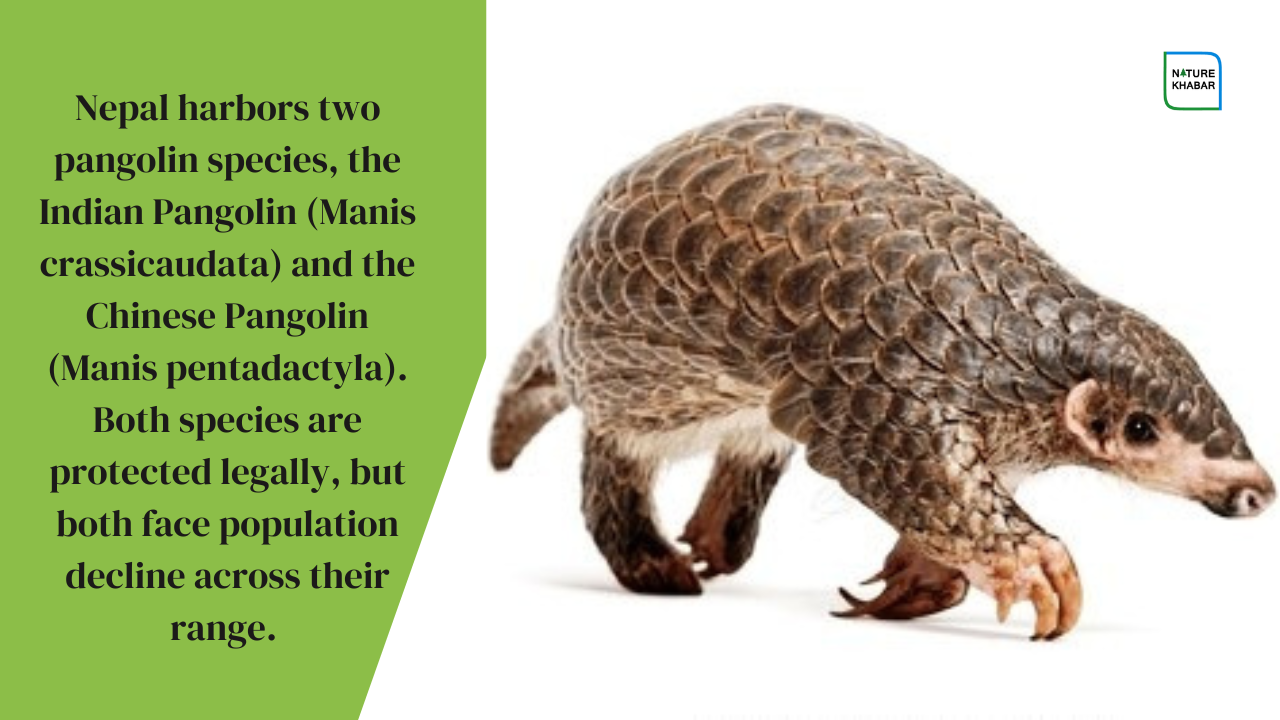Conservation need for elusive Chinese Pangolin (Manis Pentadactyla) in Nepal
- Nature Khabar

-Ashish Pariyar,
Pangolins are the elusive, shy, nocturnal, and only mammals covered with scales. They belong to the order Pholidota and Family Manidae. Out of eight pangolin species worldwide, Nepal harbors two pangolin species, the Indian Pangolin (Manis crassicaudata) and the Chinese Pangolin (Manis pentadactyla). Both species are protected legally, but both face population decline across their range. Nepal is situated in a transitional zone between the Oriental and Palearctic regions, resulting in the presence of both Chinese and Indian Pangolins. The Chinese Pangolin is known as “Kalo salak” and the Indian pangolin as “Tame salak” in Nepali.
Morphology:
The Chinese pangolin (Manis pentadactyla) is a small to medium-sized mammal weighing between 3 to 5 kg, however, some individuals may exceed 8 kg. It has a small, narrow mouth and a pointed head, measuring 40-58cm long. An adult has 15-18 rows of overlapping dark grey scales around the mid-body, along with hairs. It has a granular pad on the ventral side of the tail tip. Large ear pinna, a post-anal depression in the skin, and a narrowing near the tail's distal end help distinguish Chinese pangolin from other Asian pangolins. Males are about 30 % heavier than females. These species either stop, freeze, or curl into a ball to protect against predators or any time they feel threatened.
Diet and Reproduction:
Being myrmecophagous, they primarily feed on ants and termites while they occasionally feed on some invertebrates. Pangolins do not have teeth, so they rely on their saliva-coated adhesive tongue to feed on prey.
Chinese Pangolin are predominantly solitary, however, they come together during the breeding season. Their mating occurs during spring and summer (February- July), and females give birth during autumn or early spring (September- February). The female and the young Pangolin remain together until the offspring are independent to survive in the wild. Their gestation period lasts for about 6-7 months.
Distribution:
Chinese Pangolins have been reported from Bhutan, India, Bangladesh, Myanmar, Laos, Thailand, Vietnam, Southern China and Nepal. The presence of Pangolins has been confirmed in the 61 districts from the eastern to the far western region of Nepal. Among these, the Chinese pangolins are distributed across 27 districts of Nepal which include Bhaktapur, Baglung, Chitwan, Dhading, Dhankuta, Dolakha, Gorkha, Ilam, Jhapa, Kathmandu, Kavre, Kanchanpur, Khotang, Lalitpur, Lamjung, Makwanpur, Palpa, Parsa, Panchthar, Sankhuwasabha, Sindhuli Sindhupalchowk, Solukhumbu, Taplejung, Terathum, Ramechhap, and Bardia. Chinese pangolins are found in both protected and non-protected areas of Nepal. These species are distributed from Terai to the Mountain region of Nepal with a maximum elevation of 2400m above mean sea level.
Ecological role:
Pangolins are vital for maintaining a balanced ecosystem as adult pangolins can feed more than 70 million individuals of ants and termites per year. They are responsible for maintaining soil fertility and mitigating economic loss from ants and termites. Hence, they are also called friends of farmers. Also, the leftover burrow of the Pangolin aids in providing shelter for other small animals and a hiding place during the forest fire.
Conservation Status:
It is classified as critically endangered in the IUCN Red List of Threatened Species, Appendix-I of the CITES (Convention on International Trade of Wild Flora and Fauna). It is also protected under the National Parks and Wildlife Conservation (NPWC) Act 1973 of Nepal.
Threats:
Chinese Pangolin is facing threats due to different factors like excessive trading, hunting, habitat destruction, forest fires, climate change, lack of conservation awareness and negatively perceived by the local community. Human activities such as expanding settlements, road and dam construction, conversion of forests for agriculture, forest fires, overgrazing, soil extraction for domestic use, and drying of water sources, are significant threats to these species. Furthermore, the impacts of climate change, drought, forest fire, etc. lead to the reduction in the prey species for pangolins which will ultimately contribute to starvation and malnutrition.
Conservation efforts in Nepal:
The Government of Nepal realized the need for the Pangolin Conservation Action Plan 2018-2022. Various researchers are conducting research and conservation awareness programs on different levels of Pangolin. The pangolin park and trails have been made in Nepal to promote the conservation of Pangolin and their habitats.
Suggestions:
In spite of their legal protection, hunting and trafficking of Chinese pangolins still prevail in Nepal. Hence, the action plan and conservation strategy for Pangolin conservation should be implemented effectively. Various local-level conservation campaigns need to be conducted across the nation which will bring a positive message and attitude among people. Pangolin’s habitats and their distribution should be explored and management action needs to be employed. The ecological significance and the benefits that can flourish if established a co-existence with the human community must be minutely explained to locals as a form of community awareness.
(Ashish Pariyar is a 4th year student of the Institute of Forestry Studies, Pokhara Campus)





Feedback